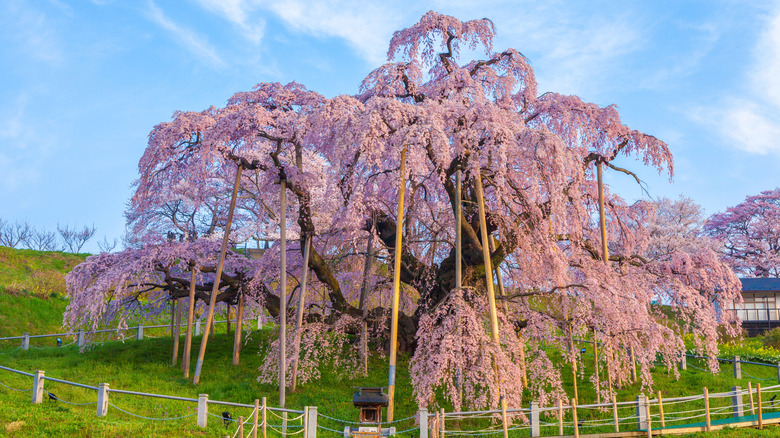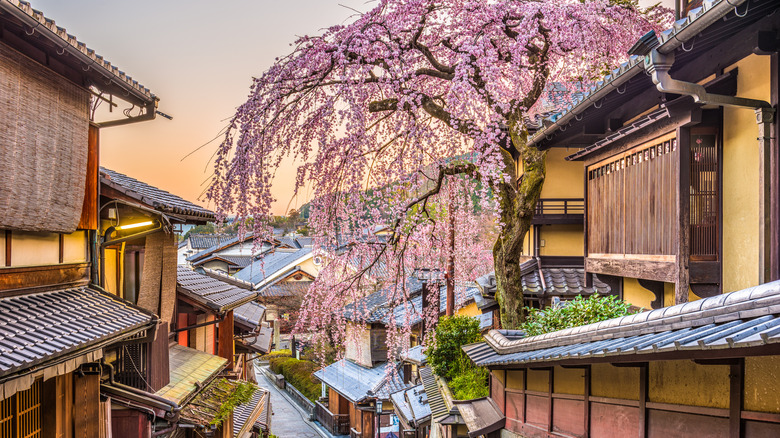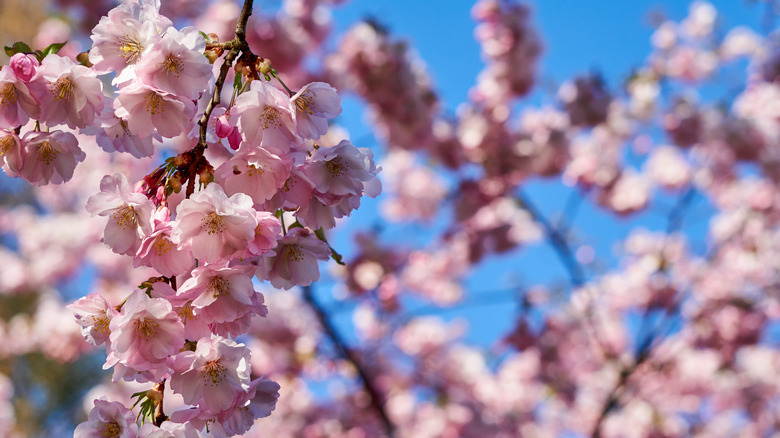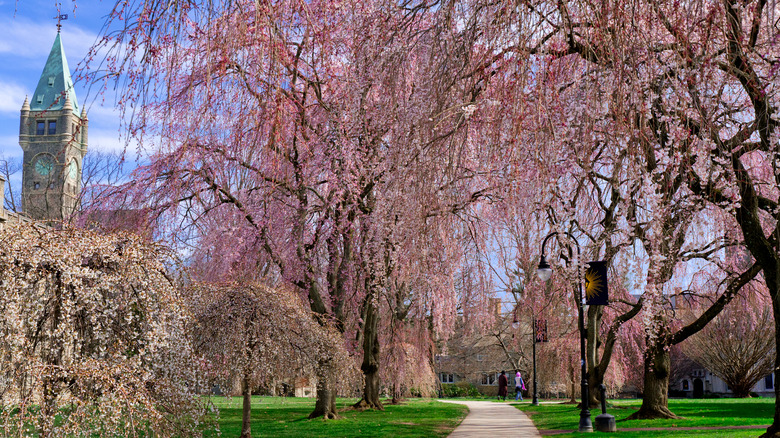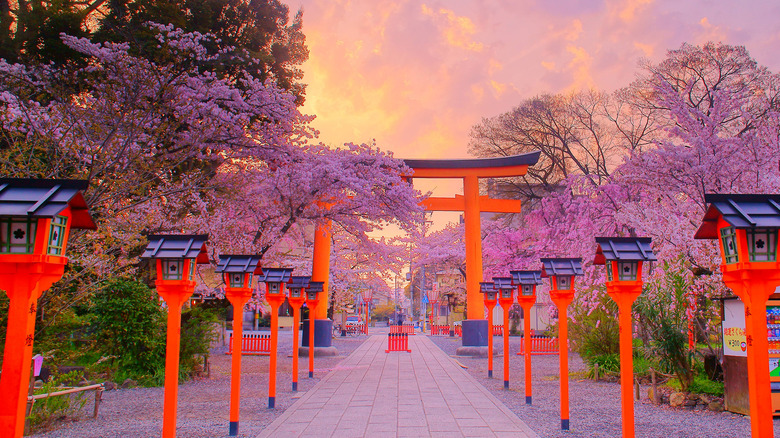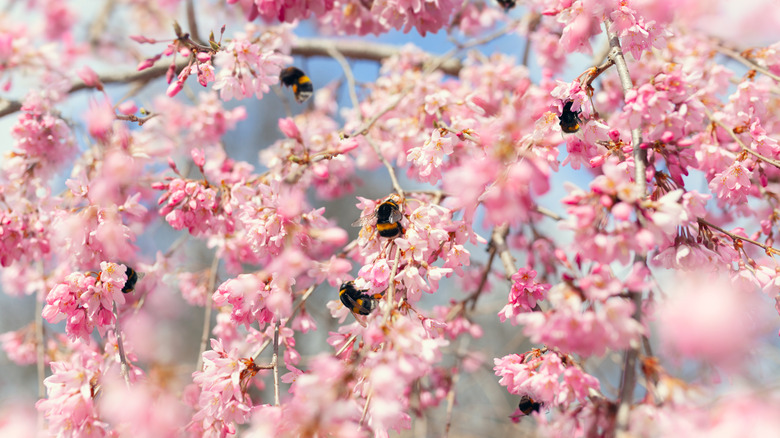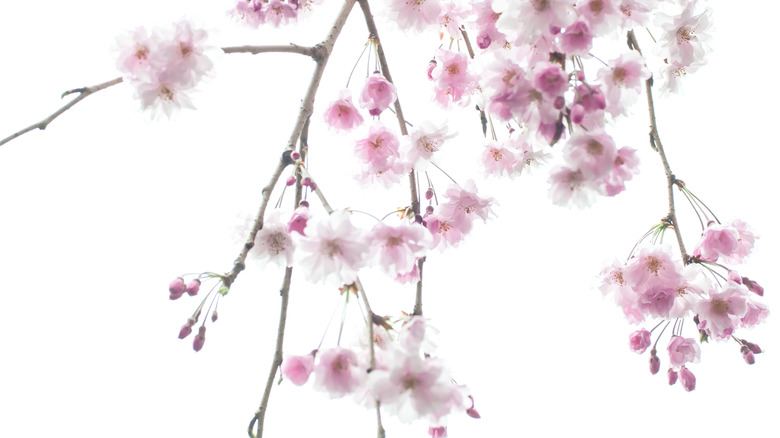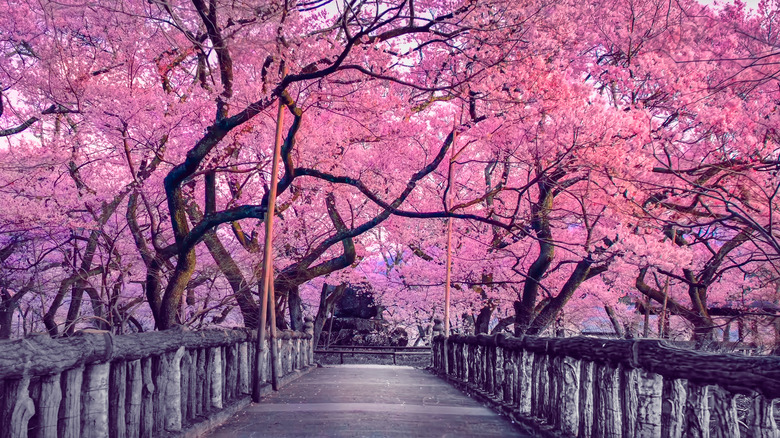How To Care For A Weeping Cherry Tree
Cherry trees provide some of the most beautiful spring foliage of any flowering variety that you might consider planting in your home's garden. The weeping cherry is a special deciduous variety of the Prunus genus (the Prunus subhirtella 'Pendula,' according to Hunker) and provides a unique touch with its distinctive hunched appearance. The Spruce estimates that a typical weeping cherry will grow to about 15 to 25 feet tall and wide. Still, they can be grafted onto more subdued rootstocks with ease to achieve a much smaller overall footprint that's perfect for a more compact garden or even in a potted courtyard space.
The Spruce dives directly into naming conventions of the weeping cherry, reporting that this type of Prunus is also commonly known as the weeping Higan cherry or Pendula Rosea, in some instances — meaning weeping pink. These trees are a fantastic ornamental addition to a border area of the lawn or even as a large pot-grown specimen that can be rearranged around a deck or outdoor furniture, given the need. Subvarieties of weeping cherry trees produce either single or double flowers and are great for attracting pollinators. In addition, the weeping form of this tree provides a unique silhouette throughout the year, and the leaves change color from a bronze hue through to deep greens and eventually back to red before falling in the colder months.
How to use a weeping cherry tree in the garden
A weeping cherry tree offers something of a spectacle to the average home garden. Gardening Know How suggests that these trees can provide a note of tranquility and peace in any backyard due to their graceful and unique profile. Weeping trees are specially selected for the softer branch structure that becomes too heavy for the main thrust of the tree to support as it continues to grow. These trees double over and begin to add length back toward the ground, as is the expectation of woody plant varieties.
Planting the weeping cherry tree as a centerpiece in the front yard makes for a fascinating visual effect that can act as a centerpiece in any home garden. Another great option for homeowners with a circular driveway is to simply plant this sapling in the center grassy area formed by the bend in the concrete. Lastly, homeowners sometimes opt to grow trees in potted conditions. According to trees.com, many different tree varieties can be grown successfully in containers, and a number of these shrubs often thrive in this environment. In addition, the ability to move a potted plant to protect it from extreme heat, lengthy exposure to direct sunlight, or the winter chill is a unique attribute of trees planted in containers.
How to grow a weeping cherry tree
It's possible to grow this kind of tree on your own, but many homeowners who choose to incorporate the beauty of a weeping cherry into their yard purchase the sapling from a nursery that they trust. Growing a weeping cherry is highly rewarding, and thankfully, it's often a simple task. Deseret News shares the secret surrounding propagation of weeping growth. First, it's important to understand that weeping tree varieties don't breed like other plants. A seed produced from the flower or fruit of a weeping cherry or other weeping trees won't carry on this trait. Instead, the quality stems from a particular plant's mutation as it grows. Some weeping trees show this growth pattern early on, while others develop it farther into maturity.
In order to propagate a weeping cherry tree, nurseries (or homeowners with a green thumb) will take cuttings from a cherry tree that exhibits this trait. Then, it's up to the gardener to decide whether to graft the cutting onto a rootstock that will elevate future growth up off the ground or plant the cutting directly into the soil and create a crawling variety. Weeping plants produce a kind of dour effect when planted directly, so grafting is often the best option to take advantage of both the natural tree profile and the weeping silhouette.
How to care for a weeping cherry tree
Clemson's Home & Garden Information Center reports that weeping cherry trees can be planted throughout the year but typically perform best when added to the garden in the fall and in hardiness zones 5 through 8. These trees love full sun, so ensure you plant them in a spot that receives lots of direct light throughout the day. A lot of light fosters many blooms, but it also keeps fungal infections at bay. The University of Minnesota Extension reports that newly planted trees require more frequent watering than others to support healthy and substantial root growth early on. Watering daily for the first few weeks after planting is best. Then, slowing down the addition of water to every two to three days from the third week until the end of the third month. After this, water weekly until the roots have been established.
Many grafted trees will produce suckers, Gardening Know How notes, and these can spell disaster for the healthy growth of the main trunk — the part of the plant you are trying to cultivate! Removing these is just like traditional pruning and should be done as soon as one sprouts up. Finally, routine pruning beyond sucker control isn't typically necessary unless removing dead, diseased, or damaged branches.
Weeping cherry tree varieties
Cherry trees that are prized for their ornamental flowering and weeping nature come in a few specialized varieties. Gardenia suggests a few favorites for the home gardener and provides a comprehensive overview of their characteristics.
- Japanese Flowering Cherry (Kiku-Shidare-Zakura) — This tree creates deep pink flowers, with as many as 100 or more petals per bloom. This weeping cherry is a compact variety that fits nicely within a smaller garden without taking up too much space.
- Double Weeping Cherry (Pendula Plena Rosea) — This tree can grow as high as 15 to 25 feet tall and equally wide while producing some of the deepest colors among flowering cherry subspecies. This old variety dates back to the 17th century, giving it a grand history and a surefire talking point in the garden.
- Weeping Cherry (Pendula Rosea) — This variety is one of the most commonly found in home gardens and cultivated green spaces worldwide. These weeping cherry trees produce a broad crown that droops and burst into dark pink blossoms in the spring that eventually fade to lighter pink. Its foliage also transforms through the seasons from deep green to brilliant reds.
- Yoshino Cherry (Shidare-Yoshino) — This is a large weeping cherry tree variety, growing to more than 40 feet over 20 to 50 years. This tree produces a pale pink flower that fades to white after the prime blossom period has passed, making for a wonderful transitional flower that pulls double duty in your yard over the short blooming period.
Is the weeping cherry tree toxic?
It's important to note that wild cherry (Prunus avium) produces twigs and leaves that are toxic to animals. Eating these components can prove fatal in dogs, cats, and even horses but exhibits no toxicity among humans (via Gardener's World). While cherry seeds contain the highest natural concentration of the toxic chemical cyanide, cherries themselves are not poisonous to animals, Wag! notes. The leaves and seeds should be avoided at all costs, though. However, even in the event of a mild poisoning that won't immediately threaten a pet's life, eating the seeds produced by cherry trees can be a health hazard to them in the form of gastrointestinal or throat blockages.
For homeowners who make pets a primary part of their lifestyle, the addition of a weeping cherry might not be the best selection. Instead, planting a sweet almond tree can provide an alternative approach to adding pink and white flowers to the yard. Bitter almonds can be problematic if actively fed to pets, but the sweet varieties make for a fine pet-safe addition and a similar pop of light and airy color through the springtime.
How to repot a weeping cherry tree
A weeping cherry can indeed thrive in a potted environment if given the right conditions. One thing that Oak Hill Gardens points out for anyone trying to grow potted trees is that temperature fluctuations will be much broader in potted soil than in dirt found in a natural, ground environment. Pots are subjected to more of the natural air environment than the ground that acts as a comprehensive heat sink. Using insulated pots or adding a dedicated heat mat to help regulate temperature can support in maintaining the all-important soil and root temperature below the trunk and leaves of any tree you're thinking of planting in a pot.
Using naturally smaller-growing rootstocks — either extreme dwarfing or dwarfing rootstocks — for grafting target weeping cherry cuttings is another crucial element of making a potted tree work in your favor. The City of Sydney News estimates that a single tree can filter 59 pounds of pollutants from the air each year and provides an excellent guide for incorporating potted trees into your home living space — whether truly indoors or as a part of your exterior space. One key feature of success is using a larger pot than you might initially estimate you'll need. Jay Scotts also reports that the typical tree will need to be moved to a new, larger container every two to three years, making use of a pot at least 4 inches larger than the previous container.
How to fertilize a weeping cherry tree
Weeping cherries can be complemented with a nitrogen-enhanced fertilizer, but Hunker suggests refraining from using any fertilizing agents in the first two years. This gives your weeping cherry tree the room it needs to establish roots in its immediate surroundings and beyond. It's believed that fertilizers in this early stage can entice a newly planted tree to remain in the comfort zone created by the fertile planting area. This means that it won't necessarily branch out and develop the wider support structure crucial to healthy growth over the coming years and decades.
SFGate recommends moderate or even minimal fertilizer application throughout the growing process of a weeping cherry tree. These saplings are often highly capable of self-regulation once established. Unless growing in a pot (in which case more regular additions may be necessary), a balanced fertilizer blend that brings equal parts nitrogen, phosphorus, and potassium to the equation with typical blends of 16-16-16, 25-4-2, or 12-8-6 is best, Sunset suggests. Making adjustments as needed is all about reading the plant's behavior. For instance, an out-of-character change in leaf color or drooping in the branches extending beyond the typical weeping variety range can signal the need for additional watering, sunlight, or fertilizer additives beyond your regular care routine.
